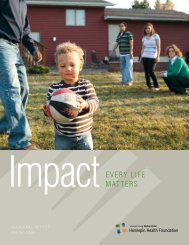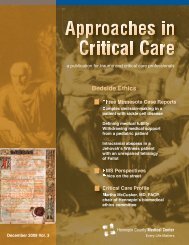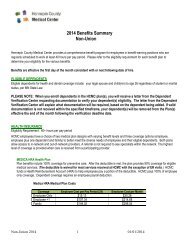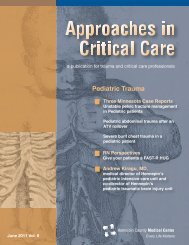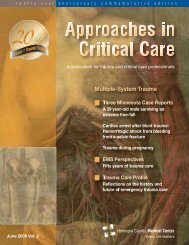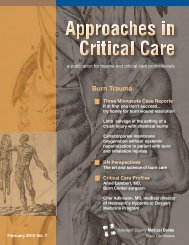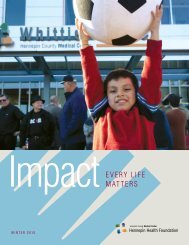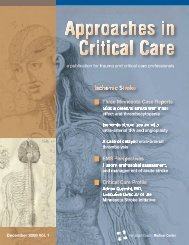HCMC_P_049062 - Hennepin County Medical Center
HCMC_P_049062 - Hennepin County Medical Center
HCMC_P_049062 - Hennepin County Medical Center
You also want an ePaper? Increase the reach of your titles
YUMPU automatically turns print PDFs into web optimized ePapers that Google loves.
Case Reports<br />
Figure Five.<br />
The LUCAS device<br />
several pounds of negative force. Newer software<br />
automatically adjusts the plunger to ensure good<br />
contact with the sternum. It is unlike human CPR,<br />
which degrades due to fatigue or distraction, and is<br />
often done at a rate too slow or too fast for optimal<br />
blood flow, does not allow for full chest wall recoil as<br />
the provider tends to lean on the chest, and must be<br />
stopped during administration of shocks. It has been<br />
shown to improve blood flow in experimental models<br />
and anecdotal reports in humans. We have found in<br />
some cases that it creates exceptional blood<br />
pressure in ED cardiac arrest patients, as measured<br />
by arterial line; and it is more likely than manual<br />
chest compression to keep the brain perfused (and<br />
therefore alive) in prolonged arrest. The LUCAS<br />
device also allows safe transport of the patient with<br />
ongoing CPR, thus making it possible to go to the<br />
cath lab with ongoing CPR.<br />
Therapeutic Hypothermia<br />
In 2002, 2 randomized studies in the New England<br />
Journal of Medicine compared therapeutic cooling for<br />
24 hours to standard care. 3, 4 These trials, and<br />
evidence from dog studies, form the basis of this now<br />
standard therapy for comatose survivors of cardiac<br />
arrest. In these studies, patients who were<br />
resuscitated from pulseless ventricular fibrillation<br />
(VF) or tachycardia (VT) were randomized within 3<br />
hours, and those who underwent hypothermia were<br />
sedated, chemically paralyzed, and externally cooled<br />
to a target temperature of 32 to 34 degrees Celsius,<br />
where they were kept for 24 hours before rewarming.<br />
Only 8% of cardiac arrest patients met eligibility<br />
criteria. The primary endpoint was good neurologic<br />
outcome at 6 months, which, when combining the 2<br />
studies, was achieved in the hypothermia group in<br />
54% vs. 37%. Mortality was 43% vs. 58%. Adverse<br />
events were not different between the groups.<br />
Based on this, the International Liaison Committee<br />
on Resuscitation advised use of therapeutic<br />
hypothermia, to 32-34 degrees for 12 to 24 hours, for<br />
unconscious adult patients with return of spontaneous<br />
circulation after out-of-hospital ventricular fibrillation<br />
arrest. 5 Therapeutic hypothermia requires intubation<br />
and paralysis and very intensive monitoring for<br />
electrolyte shifts and dysrhythmias.<br />
Conclusion<br />
Since 2003, we at <strong>Hennepin</strong> <strong>County</strong> <strong>Medical</strong> <strong>Center</strong><br />
have cooled comatose survivors of cardiac arrest.<br />
We have decided to broaden the indications for the<br />
therapy beyond those with VF or VT to those patients<br />
who have been resuscitated from asystole, pulseless<br />
electrical activity (PEA) and respiratory etiologies of<br />
cardiac arrest, as long as they have return of<br />
spontaneous circulation within 60 minutes of arrest.<br />
From January 2008 through December 2011,<br />
<strong>Hennepin</strong> had 129 patients resuscitated after cardiac<br />
arrests who were eligible for and underwent<br />
therapeutic hypothermia: 86 had VF or VT, and 43<br />
had PEA or asystole. Of the 129, 61 (47%) survived<br />
with good neurologic outcome; 6 of these had PEA or<br />
asystole as the initial rhythm. In total, 57 (44%) died,<br />
35 of whom had asystole or PEA. There were 11<br />
survivors, but with poor neurologic outcomes; 2 of<br />
these had asystole or PEA. The 56 of 86 (65%) with<br />
a shockable rhythm survived with good neurologic<br />
outcome. Most of these were before the use of the<br />
LUCAS device.<br />
This case and our survival statistics illustrate the<br />
rapid advancements occurring in the management of<br />
patients with cardiac arrest. Combining new therapies,<br />
such as those described in this case report, has the<br />
potential to improve survival even more. <br />
References<br />
1. Thiele H, Zeymer U, Neumann FJ, et al. Intraaortic balloon<br />
support for myocardial infarction with cardiogenic shock. N Engl J<br />
Med 2012; 367(14):1287-96.<br />
2. Aufderheide TP, Frascone RJ, Wayne MA, et al. Standard<br />
cardiopulmonary resuscitation versus active compressiondecompression<br />
cardiopulmonary resuscitation with augmentation<br />
of negative intrathoracic pressure for out-of-hospital cardiac arrest:<br />
a randomised trial. Lancet 2011;377(9762):301-11.<br />
3. Bernard SA, Gray TW, Buist MD, et al. Treatment of comatose<br />
survivors of out-of-hospital cardiac arrest with induced<br />
hypothermia. N Engl J Med 2002; 346(8):557-63.<br />
4. The_Hypothermia_after_Cardiac_Arrest_Study_Group. Mild<br />
therapeutic hypothermia to improve the neurologic outcome after<br />
cardiac arrest. N Engl J Med 2002; 346(8):549-56.<br />
5. Nolan JP, Morley PT, Hoek TL, Hickey RW. Therapeutic<br />
hypothermia after cardiac arrest. An advisory statement by the<br />
Advancement Life support Task Force of the International Liaison<br />
committee on Resuscitation. Resuscitation 2003;57(3):231-5.<br />
Approaches in Critical Care | January 2013 | 5



